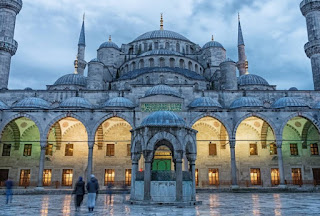Blue Mosque
History of the Blue Mosque (Sultan Ahmed Mosque) :
The Blue Mosque, also known as the Sultan Ahmed Mosque, is an iconic architectural masterpiece located in Istanbul, Turkey. Its history is closely intertwined with the Ottoman Empire and its cultural and religious significance. Here's an overview of its history:
Construction Period :
- The Blue Mosque was commissioned by Sultan Ahmed I, who ruled the Ottoman Empire from 1603 to 1617. He desired to build a grand mosque to rival the Hagia Sophia, another iconic structure in Istanbul.
- Construction of the mosque began in 1609 and was completed in 1616. It took around seven years to finish the main structure, and additional time was required for the decoration and final touches.
Architectural Design :
- The mosque was designed by the renowned Ottoman architect Sedefkar Mehmed Ağa, who was a student of the famous architect Mimar Sinan.
- The Blue Mosque is an outstanding example of Ottoman architecture, characterized by its large central dome, cascading domes, and six minarets, which was an unprecedented feature at the time.
Decoration and Tiles :
- The mosque is famously adorned with exquisite blue tiles, giving it its colloquial name "Blue Mosque." These intricate tiles cover the interior walls and the central dome's interior.
- The interior is further decorated with intricate calligraphy, floral motifs, and geometric patterns. The color blue dominates the overall design, creating a serene and harmonious atmosphere.
Cultural and Religious Significance :
- The Blue Mosque was intended to be both a place of worship and a symbol of the Ottoman Empire's power and devotion to Islam. It was designed to be a grand imperial mosque that reflected the majesty of the empire.
- The mosque's central location near the Hagia Sophia also symbolized the Ottoman Empire's desire to establish its presence and legacy in the heart of Istanbul.
Legacy :
- The Blue Mosque remains an active mosque to this day, serving as a place of worship for Muslims in Istanbul. It has also become one of the city's most visited landmarks, attracting tourists from around the world.
- Its architectural influence can be seen in other Ottoman mosques and buildings, reflecting the lasting impact of its design and aesthetics.
Visitor Experience :
- Visitors can marvel at the intricate tilework, calligraphy, and architectural details of the mosque's interior. The spacious courtyard and the six minarets are also popular attractions.
- It's important to note that the mosque is still used for daily prayers, so visitors should respect its status as a place of worship and follow appropriate dress code and etiquette.
The Blue Mosque stands as a testament to Ottoman architecture and the empire's dedication to religion and artistry. Its stunning design, vibrant tilework, and historical significance make it an integral part of Istanbul's cultural and architectural heritage.
Attractions of the Blue Mosque (Sultan Ahmed Mosque):
Exquisite Tilework:
The interior of the Blue Mosque is adorned with tens of thousands of blue tiles, giving the mosque its distinctive name. The intricate tilework features intricate floral patterns, geometric designs, and calligraphy.
Central Dome:
The mosque's main dome is an architectural marvel, spanning more than 23 meters (75 feet) in diameter and reaching a height of approximately 43 meters (141 feet). The interior of the dome is adorned with beautiful blue tiles that create a celestial ambiance.
Six Minarets:
The Blue Mosque is famously known for its six minarets, which was an unprecedented feature at the time of its construction. Minarets are the towers from which the call to prayer is made.
Courtyard:
The spacious courtyard of the Blue Mosque features marble flooring and is surrounded by a colonnade with domed pavilions. It's a serene area where visitors can gather before or after prayers.
Prayer Area:
The main prayer hall features rows of elegant columns supporting the arches, creating a sense of grandeur and spaciousness. The mihrab (prayer niche) and the intricately designed pulpit (minbar) are notable elements of the prayer area.
Calligraphy:
Elaborate calligraphy in Arabic script adorns the interior walls of the mosque. The inscriptions include verses from the Quran, as well as the names of the Prophet Muhammad and the first four caliphs.
Facts about the Blue Mosque:
Name Origin:
The mosque is commonly known as the Blue Mosque due to its blue interior tiles. The Turkish name, Sultanahmet Camii, honors Sultan Ahmed I, who commissioned its construction.
Mirrors the Hagia Sophia:
Sultan Ahmed I aimed to surpass the grandeur of the Hagia Sophia with the Blue Mosque. The decision to add six minarets to the mosque initially caused controversy, as this number was reserved for the Prophet's Mosque in Medina.
Continued Use:
The Blue Mosque is an active place of worship, and it remains one of Istanbul's most important functioning mosques. It's open for prayers and hosts congregational Friday prayers.
Tourist Attraction:
Despite its religious function, the Blue Mosque is also a popular tourist attraction, drawing visitors from around the world who come to admire its architectural beauty and historical significance.
Timelessness:
The mosque's design and architectural elements have stood the test of time, and it continues to be an iconic symbol of Istanbul's skyline.
Spiritual Experience:
Visitors are welcome to explore the mosque's interior, but it's essential to respect its role as a place of worship. It's customary for visitors to remove their shoes and dress modestly when entering the mosque.
The Blue Mosque's intricate design, historical importance, and spiritual atmosphere make it a must-visit destination for anyone interested in exploring Istanbul's rich cultural and architectural heritage.





0 Comments